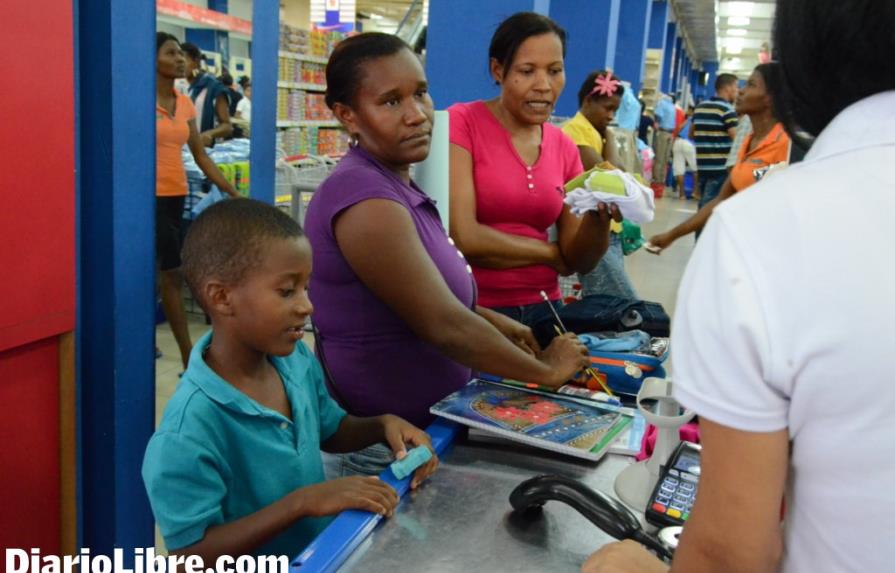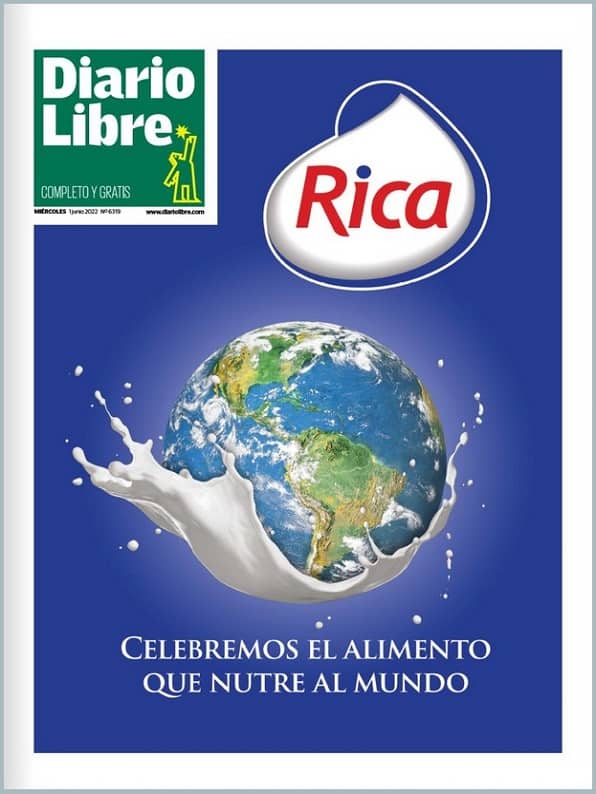The sacrifice of sending a child to school

Four families, a common reality: to send a child to school in this country is a sacrifice that cuts into the family budget, because in the majority, the parents have to take out loans to cover the high costs of school supplies and books.
"I took a loan to buy school supplies"
Dominga Perez, an unemployed single mother, who lives in Los Girasoles, took a RD $5000 loan at 20% interest, to buy the school supplies for her 6-year-old son, who is going to preschool, at a low-cost private school. With her long list of requirements in her hand, she permitted Diario Libre to accompany her trip along Duarte Avenue as she looks for the supplies for her little one.
The list of requirements, somewhat wrinkled, presented several checkmarks, indicating the supplies that had been included in her basket. However there were many points that still needed to be scratched out, including one that asks for "used magazines." "These teachers think that we are rich," the woman complains, while she tries not to lose her son in the crowded store. "I'm doing this because I missed the registration deadline for the public school... And I could not find an opening," she later explained.
For her shopping along Duarte Avenue, Dominga carried RD $1800 with the hope of stretching them to the utmost. This budget does not include the books (four) that she has to buy at the private school. "I still don't know how much they will cost because the teacher said she was going to find out for me," she says.
On her first trip through the cashier line he bought some blue jeans, a blue polo shirt, four 200 page notebooks, a lunchbox, a region of white paper, two boxes of colored pencils, a pencil sharpener, two erasers, a bottle of glue, two sheets of craft paper, and three pencils. The total cost: RD $1056. She has RD $744 pesos left. She still has to get colored thread, toilet paper, a backpack.....
And shoes, aren't you going to get some? She is asked. "For now he will go with some old shoes, until some money shows up...."
"I had to do without several things in order to prepare the girls"
Anna Rodriguez was buying some of the school supplies together with her two girls at a commercial establishment. In her shopping cart she had notebooks, pencils, ballpoint pens, white out, blank paper, a pair of khaki pants, book covers, a T-shirt, a set of rulers, a pencil case.... Total cost: RD $5828. Previously, she said that she had spent RD $6004 uniforms and backpacks. She calculates that sending each girl to school means an expense of RD $15,000. Although she did not have to take out loans like other parents, Anna said that she did "have to cut back on several little things" in order not to alter the family budget even more.
"The prices are exorbitant"
Maribel Espinal slumps her shoulders, a sign of disappointment, when she is asked about how much she will spend on school supplies for her daughter, who is studying her last year of high school and a middle-class private school, located in East Santo Domingo.
She complains of the cost of the books. "In reality the prices are exorbitant," she says and she opens her pocketbook. There she has five used books that she acquired on Caracas Street, in Villa Francisca. In order to get them she says "I had to take like 10 books from last year and pay an additional RD $1800."
Of the extensive list required by the school, she is missing five more books, each one costing RD $1100. "This is abusive, isn't it?", She said seeking solidarity. And she added that just in books she will have to use the RD $7000 bonus that the company she works for gave her. "And I have still not bought the first notebook," she says she estimates that she will spend more than RD $10,000.
"It is a total sacrifice"
Catalina and Adriano, enjoyed together with their daughter, a little ice cream on Duarte Avenue, to cool off from the heat of 11 o'clock in the morning. Adriano holds a stuffed plastic bag. Inside he has nearly 3000 pesos in school supplies for his daughter, who is going into the fourth grade in a public school.
They live in Los Guandules, a barrio in the capital and a live on Adriano's income, RD $12,500 a month. In the bag they only have a backpack (RD $660), to khaki pants (RD $460 and RD $395, each), and RD $195 shirt and some shoes (RD $695).
"It is piecemeal," says Catalina. "We are by what is most needed," she explains. "It costs a lot," she adds, to send a child to school.
"It is a total sacrifice," her husband interrupts. "You have to adapt because you have to do it. It is something that you have to do that costs what it costs."
The same as other families, that of Catalina and Adriano had to go into debt. They took a loan of RD $5000 "and we're going to need more," Catalina commented, "because we haven't bought notebooks or pencils."
"I took a loan to buy school supplies"
Dominga Perez, an unemployed single mother, who lives in Los Girasoles, took a RD $5000 loan at 20% interest, to buy the school supplies for her 6-year-old son, who is going to preschool, at a low-cost private school. With her long list of requirements in her hand, she permitted Diario Libre to accompany her trip along Duarte Avenue as she looks for the supplies for her little one.
The list of requirements, somewhat wrinkled, presented several checkmarks, indicating the supplies that had been included in her basket. However there were many points that still needed to be scratched out, including one that asks for "used magazines." "These teachers think that we are rich," the woman complains, while she tries not to lose her son in the crowded store. "I'm doing this because I missed the registration deadline for the public school... And I could not find an opening," she later explained.
For her shopping along Duarte Avenue, Dominga carried RD $1800 with the hope of stretching them to the utmost. This budget does not include the books (four) that she has to buy at the private school. "I still don't know how much they will cost because the teacher said she was going to find out for me," she says.
On her first trip through the cashier line he bought some blue jeans, a blue polo shirt, four 200 page notebooks, a lunchbox, a region of white paper, two boxes of colored pencils, a pencil sharpener, two erasers, a bottle of glue, two sheets of craft paper, and three pencils. The total cost: RD $1056. She has RD $744 pesos left. She still has to get colored thread, toilet paper, a backpack.....
And shoes, aren't you going to get some? She is asked. "For now he will go with some old shoes, until some money shows up...."
"I had to do without several things in order to prepare the girls"
Anna Rodriguez was buying some of the school supplies together with her two girls at a commercial establishment. In her shopping cart she had notebooks, pencils, ballpoint pens, white out, blank paper, a pair of khaki pants, book covers, a T-shirt, a set of rulers, a pencil case.... Total cost: RD $5828. Previously, she said that she had spent RD $6004 uniforms and backpacks. She calculates that sending each girl to school means an expense of RD $15,000. Although she did not have to take out loans like other parents, Anna said that she did "have to cut back on several little things" in order not to alter the family budget even more.
"The prices are exorbitant"
Maribel Espinal slumps her shoulders, a sign of disappointment, when she is asked about how much she will spend on school supplies for her daughter, who is studying her last year of high school and a middle-class private school, located in East Santo Domingo.
She complains of the cost of the books. "In reality the prices are exorbitant," she says and she opens her pocketbook. There she has five used books that she acquired on Caracas Street, in Villa Francisca. In order to get them she says "I had to take like 10 books from last year and pay an additional RD $1800."
Of the extensive list required by the school, she is missing five more books, each one costing RD $1100. "This is abusive, isn't it?", She said seeking solidarity. And she added that just in books she will have to use the RD $7000 bonus that the company she works for gave her. "And I have still not bought the first notebook," she says she estimates that she will spend more than RD $10,000.
"It is a total sacrifice"
Catalina and Adriano, enjoyed together with their daughter, a little ice cream on Duarte Avenue, to cool off from the heat of 11 o'clock in the morning. Adriano holds a stuffed plastic bag. Inside he has nearly 3000 pesos in school supplies for his daughter, who is going into the fourth grade in a public school.
They live in Los Guandules, a barrio in the capital and a live on Adriano's income, RD $12,500 a month. In the bag they only have a backpack (RD $660), to khaki pants (RD $460 and RD $395, each), and RD $195 shirt and some shoes (RD $695).
"It is piecemeal," says Catalina. "We are by what is most needed," she explains. "It costs a lot," she adds, to send a child to school.
"It is a total sacrifice," her husband interrupts. "You have to adapt because you have to do it. It is something that you have to do that costs what it costs."
The same as other families, that of Catalina and Adriano had to go into debt. They took a loan of RD $5000 "and we're going to need more," Catalina commented, "because we haven't bought notebooks or pencils."


 Diario Libre
Diario Libre
 Diario Libre
Diario Libre